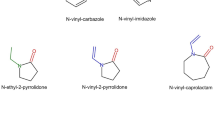Summary
Rats have been pretieatet with 6-nitro-1.2.3-benzothiadiazole which completely blocks metabolism of vinyl chloride. If the animals are exposed to atmospheric vinyl chloride, formation of an equilibrium between the compound in the gas phase and in the animal's orgnism is observed. Unmetabolized vinyl chloride is concentrated in adipose tissue. The distribution pattern of vinyl chloride in different organs of the rat is constant over the concentration range of 25–10,000 ppm of vinyl chloride in the exposure atmosphere. Distribution of metabolites of vinyl chloride contrasts to that of the original compound; metabolites primarily are concentrated in liver and in kidneys.
Zusammenfassung
Wird Vinylchlorid aus der Atmosphere eingeatmet, so stellt sich ein Gleichgewicht zwischen dem Vinylchlorid in der Luft und dem Organismus ein. In erster Linie reichert sich nicht metabolisiertes Vinylchlorid im Fettgewebe an. Für dieses Verteilungsverhalten dürfte die Lipophilie des Vinylchlorid Ausschlag gebend sein. Das Konzentrationsverhältnis von Vinylchlorid in einzelnen Organen bleibt über den gesamten untersuchten Konzentrationsbereich von 25 his 10.000 ppm Vinylchlorid in der Expositionsatmosphäre konstant. Aus dem Gleichgewicht wird Vinylchlorid dem Metabolismus zugeführt. Metabolite reichern sich, im Gegensatz zum unveränderten Vinylchlorid, vor allem in Leber und Niere an.
Similar content being viewed by others
Literatur
Bolt, H.M., Kappus, H., Buchter, A., Bolt, W.: Disposition of 1,2-14C-vinyl chloride in the rat. Arch. Toxikol. 35, 153–162 (1976)
Bray, G.A.: A simple efficient liquid scintillator for counting aqueous solutions in a liquid scintillation counter. Anal. Biochem. 1, 279–285 (1960)
Green, T., Hathway, D.E.: The biological fate in rats of vinyl chloride in relation to its ontogenicity. Chem.-biol. Interactions, 11, 545–562 (1975)
Hefner, R.E., Watanabe, P.G., Gehring, P.J.: Preliminary studies of the fate of inhaled vinyl chloride monomer in rats. Ann. N.Y. Acad.Sci. 246, 135–148 (1975)
Kappus, H., Bolt, H.M., Buchter, A., Bolt, W.: Rat liver microsomes catalyse covalent binding of 14C-vinyl chloride to macromolecules. Nature 257, 134–135 (1975)
Norpoth, K., Müller, G., Witting, U., Gottschalk, D., Gottschalk, I.: Untersuchungen über den Stoffwechsel des Vinylchlorids und über Wirkungen der VinylchloridInhalation auf Regulationsmechanismen des Leberstoffwechsels. (Dtsch. Ges. Arbeitsmed.) Stuttgart: Gentner 1976
Radwan, Z., Henschler, D.: Uptake and metabolism of vinyl chloride in the isolated perfused rat liver preparation. Naunyn-Schmiedebergs Arch. Pharmacol., Suppl. 287, R 100 (1975)
Watanabe, P.G., McGowan, G.R., Gehring, P.J.: Fate of 14C-vinyl chloride after single oral administration in rats. Toxicol. Appl. Pharmacol. 36, 339–352 (1976a)
Watanabe, P.G., McGowan, G.R., Madrid, E.O., Gehring, P.J.: Fate of 14C-Vinyl chloride following inhalation exposure in rats. Toxicol. Appl. Pharmacol. 37, 49–59 (1976b)
Author information
Authors and Affiliations
Rights and permissions
About this article
Cite this article
Buchter, A., Bolt, H.M., Kappus, H. et al. Die gewebsverteilung von 1,2-14c-vinylchlorid bei der ratte. Int. Arch Occup Environ Heath 39, 27–32 (1977). https://doi.org/10.1007/BF00381548
Received:
Accepted:
Issue Date:
DOI: https://doi.org/10.1007/BF00381548




